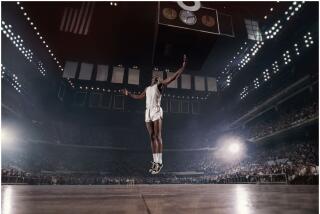Faucet Firm Tries to Tap New Markets : Ads Aim at Turning Price Pfister’s Name Into a Household Fixture
- Share via
Price Pfister’s approach always has been to make its bathroom and kitchen fixtures seem glitzy. The Pacoima company’s catalogues are filled with photos of bathtubs adorned with its imported crystal knobs, polished brass shower heads and antique bronze faucets.
But the audience for the Pacoima company’s pitch has been limited; the catalogues have gone mainly to plumbers and parts distributors who buy faucets en masse.
Now Price Pfister wants to show off its top-of-the-line wares directly to consumers--in home-improvement magazines and through a national television advertising campaign, already kicked off in eight cities.
‘Biggest Challenge’
The aim is to get greater name recognition and improve on its generally acknowledged standing as the No. 3 home faucet maker in the country. “Becoming No. 1 is our biggest goal and our biggest challenge,” said Peter S. Gold, company president.
The privately held company makes plain chrome faucets as well. In fact, only 10% to 15% of faucets sold industrywide are decorative, making up about 30% of total revenue.
But, Gold says, Price Pfister figures the best way to sell its faucets is to “put its best foot forward.” So the mass-market ads show its crystal knobs photographed with the kind of reverence more normally given to diamonds. The company also tries to make faucets sexy by filling its catalogues with photos of towel-clad and blurred naked women.
The company sees itself as the Cadillac of the decorative faucet business, manufacturing fixtures that retail for up to $100 (a plain chrome faucet goes for about $20). The most expensive faucets, with their gold-plated and crystal handles, are the Rolls Royces of the industry. They cost as much as $400 each.
Competitors Dominate
Gold acknowledges that he has a way to go before he can be anointed king of the faucet business. The company will have to gain ground in territory where the top two companies--Delta Faucet of Indianapolis, a subsidiary of Masco Corp., and Moen of Elyria, Ohio, a division of Stanadyne--already dominate, he said.
Price Pfister, whose annual sales have doubled since 1983 to more than $100 million, has fared best in the Sun Belt and Western states, according to Larry Dill, editor of Reeves Journal, a Laguna Hills-based plumbers’ trade magazine.
Delta and Moen control the East and Midwest, he said. Delta reported sales last year of about $225 million a year; Moen’s were $173 million.
“They’re a dominant factor in the West, but we don’t worry too much about them elsewhere,” Robert E. Stuart, executive vice president for Stanadyne, said of Price Pfister.
Because most faucets basically work the same way, Gold said, sales depend on good relationships with the plumbers and hardware wholesalers who buy the merchandise. Gold frequently invites plumbers from out of town to tour the plant.
New home construction accounts for 50% of faucet sales, according to the Plumbing Manufacturers Institute, a trade group of 55 plumbing-parts manufacturers based in Glen Ellyn, Ill.
Line for Do-It-Yourselfers
Other faucets are sold for remodeling and repair. Gold said the top-of-the-line faucets sell well to remodelers. Price Pfister also sells a line of faucets to hardware stores for do-it-yourselfers.
Price Pfister faucets are made at the company’s 600,000-square-foot Pacoima plant, which employs 1,350 people. The process is fairly simple: Most of the six to eight faucet parts are made from metal rods that are melted in a furnace, then molded and threaded.
Most of the inner parts are made of brass. The company’s plant makes more than 90% of the parts used in its faucets.
Price Pfister is owned by three principals: Gold, who joined Price Pfister as a salesman in 1956, Sydney Irmas, a director, and David Rousso, an executive vice president. Gold and Irmas hold equal shares of unspecified size. Rousso’s stake is smaller.
Acquired Firm in 1983
The three executives bought Price Pfister in 1983 for $35 million from an investment banking firm that had bought Norris Industries of Long Beach, Price Pfister’s parent company, in a leveraged buy-out two years earlier.
The company had a humble beginning. It was founded by Emil Price and William Pfister in 1910 as a manufacturer of gasoline generators for areas in which electricity was not yet available. Most Price Pfister generators were sold to farmers.
Two years after opening, the company moved into garden valves, the kind of faucets used to hook up garden hoses. During the world wars, Price Pfister, with a plant in downtown Los Angeles, made special valves and fittings for the military.
The company grew into a home-faucet company in the post-1945 housing boom and moved to Pacoima in 1960. Nine years later, Norris purchased Price Pfister and Gold became president.
Paul J. Koenig, Delta Faucet’s vice president for marketing, said he thinks name recognition is Price Pfister’s biggest barrier to catching up to Delta and Moen.
About 75% of those shopping for fixtures are aware of the Delta Faucet brand name, Koenig said. He said Price Pfister is known by only 15% of the public. Koenig also said people who have heard of Delta are aware of the product’s distinguishing feature: Its faucet has a single lever, which rotates on a ball, to control hot and cold water.
Gold acknowledges that Price Pfister is not well-recognized. Its advertisements are trying to combat that with the sexy pictures and a slogan, “The pfabulous pfaucet with the pfunny name.”
More to Read
Inside the business of entertainment
The Wide Shot brings you news, analysis and insights on everything from streaming wars to production — and what it all means for the future.
You may occasionally receive promotional content from the Los Angeles Times.










